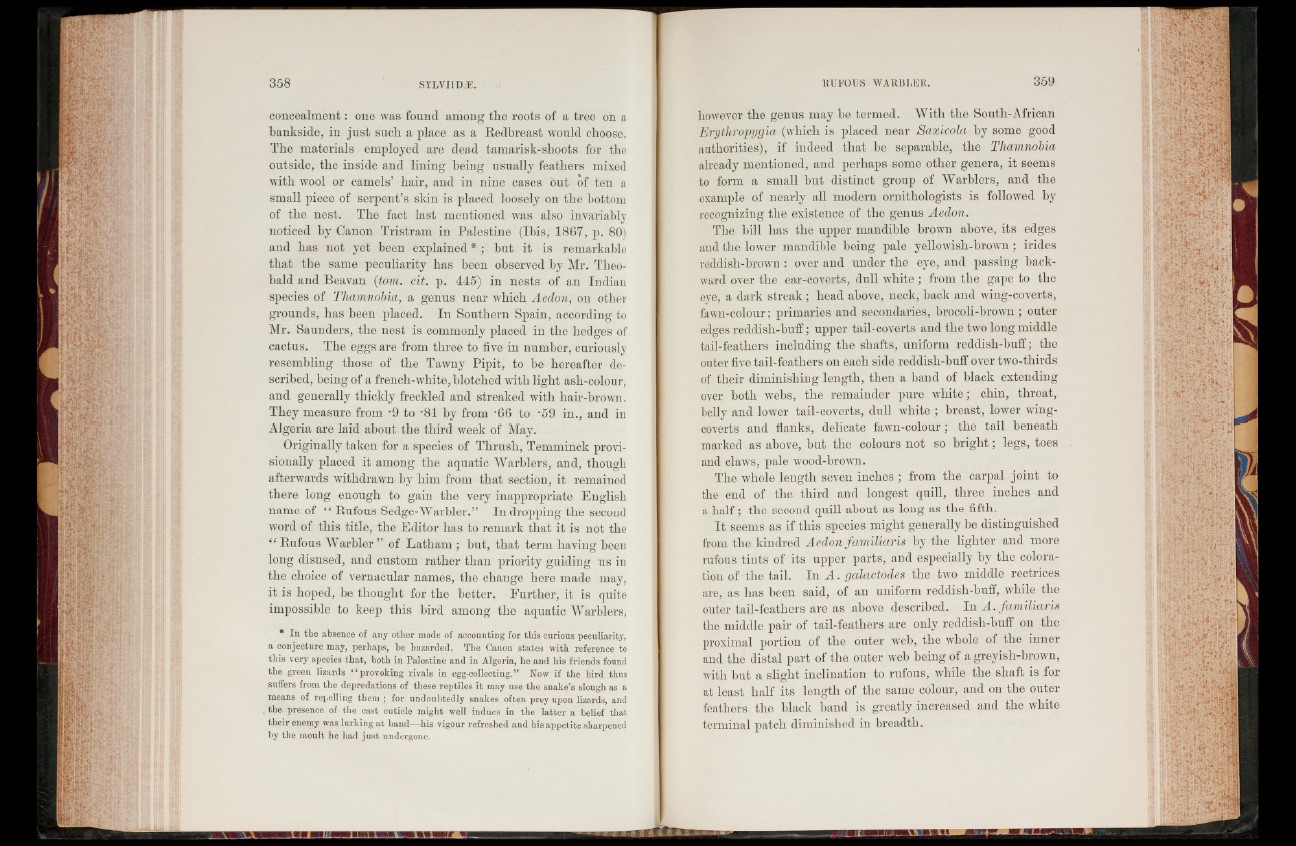
concealment: one was found among the roots of a tree on a
bankside, in just such a place as a Redbreast would choose.
The materials employed are dead tamarisk-shoots for the
outside, the inside and lining being usually feathers mixed
with wool or camels’ hair, and in nine cases out of ten a
small piece of serpent’s skin is placed loosely on the bottom
of the nest. The fact last mentioned was also invariably
noticed by Canon Tristram in Palestine (Ibis, 1867, p. 80)
and has not yet been explained * ; but it is remarkable
that the same peculiarity has been observed by Mr. Theobald
and Beavan (tom. cit. p. 445) in nests of an Indian
species of Thamnobia, a genus near which Aedon, on other
grounds, has been placed. In Southern Spain, according to
Mr. Saunders, the nest is commonly placed in the hedges of
cactus. The eggs are from three to five in number, curiously
resembling those of the Tawny Pipit, to be hereafter described,
being of a french-white, blotched with light ash-colour,
and generally thickly freckled and streaked with hair-brown.
They measure from -9 to -81 by from -66 to -59 in., and in
Algeria are laid about the third week of May.
Originally taken for a species of Thrush, Temminck provisionally
placed it among the aquatic Warblers, and, though
afterwards withdrawn by him from that section, it remained
there long enough to gain the very inappropriate English
name of “ Rufous Sedge-Warbler.” In dropping the second
word of this title, the Editor has to remark that it is not the
“ Rufous Warbler ” of Latham ; but, that term having been
long disused, and custom rather than priority guiding us in
the choice of vernacular names, the change here made may,
it is hoped, be thought for the better. Further, it is quite
impossible to keep this bird among the aquatic Warblers,
* In the absence of any other mode of accounting for this curious peculiarity,
a conjecture may, perhaps, be hazarded. The Canon states with reference to
this very species that, both in Palestine and in Algeria, he and his friends found
the green lizards “ provoking rivals in egg-collecting.” Now if the bird thus
suffers from the depredations of these reptiles it may use the snake’s slough as a
means of repelling them ; for undoubtedly snakes often prey upon lizards, and
the presence of the cast cuticle might well induce in the latter a belief that
their enemy was lurking a t hand—his vigour refreshed and his appetite sharpened
by the moult he had just undergone.
however the genus may be termed. With the South-African
Erythropygia (which is placed near Saxícola by some good
authorities), if indeed that be separable, the Thamnobia
already mentioned, and perhaps some other genera, it seems
to form a small but distinct group of Warblers, and the
example of nearly all modern ornithologists is followed by
recognizing the existence of the genus Aedon.
The bill has the upper mandible brown above, its edges
and the lower mandible being pale yellowish-brown ; irides
reddish-brown : over and under the eye, and passing backward
over the ear-coverts, dull white ; from the gape to the
eye, a dark streak; head above, neck, back and wing-coverts,
fawn-colour; primaries and secondaries, brocoli-brown ; outer
edges reddish-buff; upper tail-coverts and the two long middle
tail-feathers including the shafts, uniform reddish-buff; the
outer five tail-feathers on each side reddish-buff over two-thirds
of their diminishing length, then a band of black extending
over both webs, the remainder pure white; chin, throat,
belly and lower tail-coverts, dull white ; breast, lower wing-
coverts and flanks, delicate fawn-colour; the tail beneath
marked as above, but the colours not so b rig h t; legs, toes
and claws, pale wood-brown.
The whole length seven inches ; from the carpal joint to
the end of the third and longest quill, three inches and
a h a lf; the second quill about as long as the fifth.
It seems as if this species might generally be distinguished
from the kindred Aedon familiaris by the lighter and more
rufous tints of its upper parts, and especially by the coloration
of the tail. In A . galactodes the two middle rectrices
are, as lias been said, of an uniform reddisli-buff, while the
outer tail-feathers are as above described. In A. familiaris
the middle pair of tail-feathers are only reddish-buff on the
proximal portion of the outer web, the whole oí the inner
and the distal part of the outer web being of a greyish-brown,
with but a slight inclination to rufous, while the shaft is for
at least half its length of the same colour, and on the outer
feathers the black band is greatly increased and the white
terminal patch diminished in breadth.